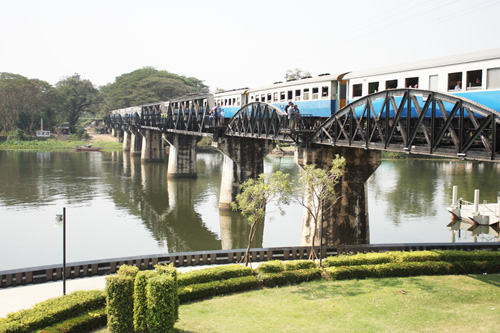Destinations
Kanchanaburi

Not many people know the city by this name, but when you say” the Bridge on the River Kwai”, and then everyone knows where we are.
Kanchanaburi lies approximately 180 kilometers west of Bangkok and has more things to offer besides the infamous bridge. Among other things you find beautiful nature and beautiful landscapes.
Going back to the bridge – you find this in the town itself. The history behind the bridge dates back to WWII where the army of the Japanese Emperor conquered most of Southeast Asia and planned an attack on India and the British troops which were stationed in India.
The Japanese needed a lot of material to aid the attack and this had to be transported through Burma (Myanmar today) and the jungle. Therefore the Japanese needed a railway connection which would connect the existing railway network in Thailand and Burma respectively. This railway, which needed to be built, would be 415 kilometers long. The Japanese used 60,000 prisoners of war and about 200,000 Asians who all worked under miserable conditions to build the railway in a short period of time. To make this connection, they took down a number of bridges in most of Southeast Asia and moved them to the places where they were needed. The largest of the bridges which was moved to Kanchanaburi in Thailand came from Java and this bridge crossed the river Mae Yai (today known as River Kwai Yai). The building of the bridge and railway made Kanchanaburi a central part for all the work done in Thailand. Even today the town is still an assembly point for everyone who is interested in the bridge and the railway.
During the construction of the railway about 114,000 people died. This has given the railway the unfortunate name “Death Railway”.
In the town you can still see the railway which today is used for general traffic and for the tourists who would like to see it. Contrary to what many think the bridge is not constructed in wood as you see in the film, but out of concrete and steel. The bridge is almost 340 meters long. By the bridge you can see a couple of trains which were used over time on the railway.
85 kilometers north of the city you find one of the most notorious stretches on the railway over the bridge. This place is called HellfirePassand 3500 POWs worked here. Many of the prisoners died during the work on the 150 meter long cleft which is cut into a cleft 16 meters high.
By the pass you can visit the museum run by the Australian government. The museum shows effects from WWII and you find more information about Hellfire Pass. Down in the pass itself you can see the cleft made by the POWs as well as all the effects found in the area. You can also take a memorial walk along the railway and sense the atmosphere and feeling which the place holds plenty off.
Apart from the railway, there are other experiences waiting to be seen.
About 40 kilometers from the bridge is a small temple on one of the minor main roads. Although a temple is not a rare sight in Thailand, this one has served as a refuge for wounded and threatened animals for several years, and the temple’s “main visitors” are some 20 tigers, hence the name “Tiger Temple”.
Every day between 1 pm and 5 pm the monks take the tigers out of their cages and walk them down to a small valley where the tigers can be in their element. When the tigers have settled down, those who are brave enough are invited to spend time with the tigers (against a donation). You may then sit with the tigers, pet them or stroke them on their tummy.Certain restrictions apply to children.
Apart from the tigers in the temple the monks also look after some large birds of prey, which have flown into electricity grids, and boars, water buffalos and several peacocks.
If you are near Kanchanaburi you should take the opportunity to visit the Tiger Temple. It gives you memories for life. The entrance fee is 300 Baht per person (Feb. 2007).
The Sai Yok National Park is one of Thailand’s most beautiful national parks also in the Kanchanaburi province.
In the national park you find picturesque nature and beautiful waterfalls. You shouldn’t miss the opportunity to sail up the real River Kwai (there is a river which was always named Mae Nam Kwai. Although this one does not cross the railway as Mae Nam Kwai Yai does). You can do this on a so called Longtail boat.
When talking about waterfalls, don’t miss the Sai Yok Noi waterfall, which you find midway between Kanchanaburi and Sai Yok national park. This beautiful area boasts a fantastic waterfall in which you can take a dip if you so please.
Around Kanchanaburi live several small groups of people who call themselves the ”mong people”. These people claim to be the original Thai people. In the large hotels you can see the mong dance show and learn more about their culture.






